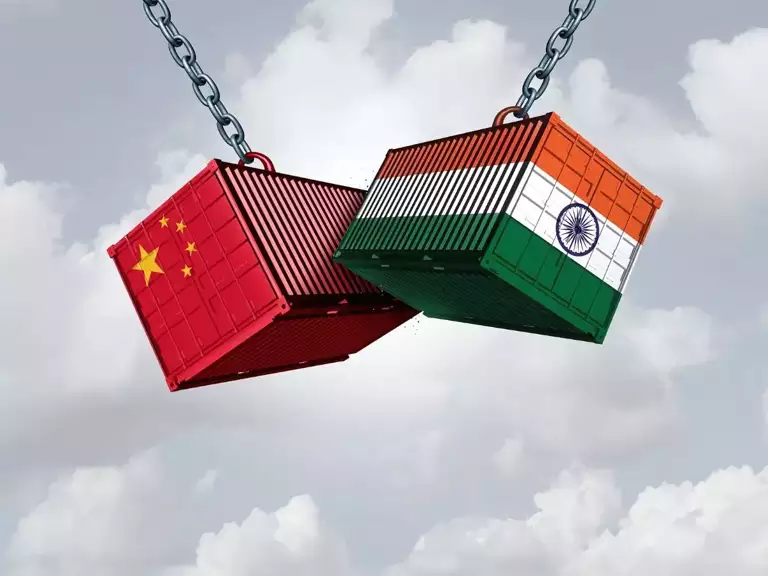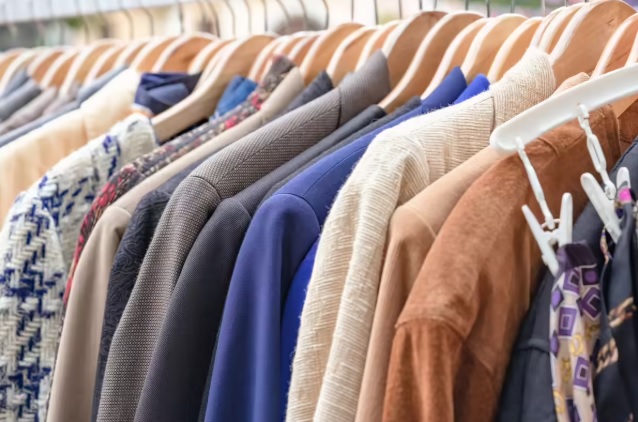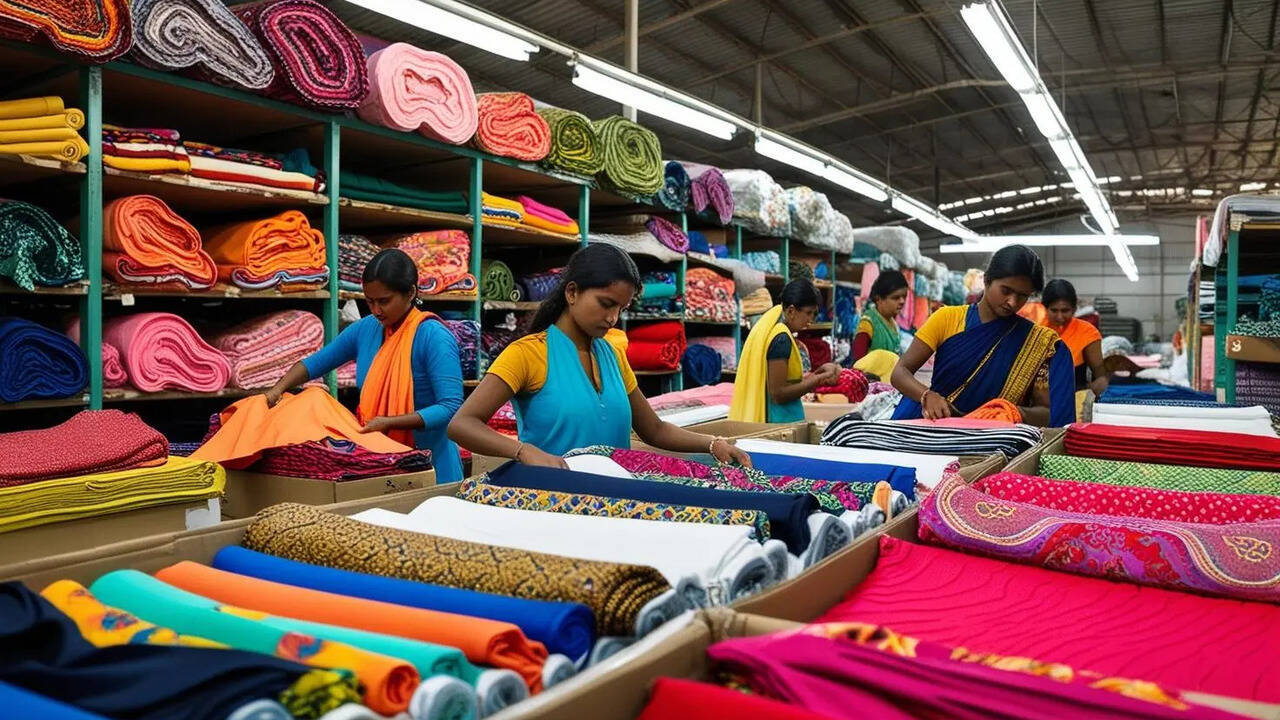FW
Products including garments made in India have got a huge potential in the global market. Many buyers are inclined to source their requirements from India, keeping in mind advantageous factors like political relationship, cultural relationship, quality manufacturing, communication angle and above all dependability and responsibility.
As for the share of US apparel imports from India, India contributes four per cent of US imports with a growth of eight per cent whereas China has registered only a two per cent growth year on year. There is potential to increase Indian exports to the US, particularly knitwear and apparels.
Meanwhile Sourcing at Magic will be held in the US from August 14 to 17. It’s North America's largest and most comprehensive sourcing event, reflecting the fashion supply chain at its most complete. It offers access to over 35 countries representing the world’s most important markets.
The fair is also a convenient space for retail buyers, global importers, licensees and brands to meet and conduct business with offshore manufacturers like India and contract suppliers from the international manufacturing countries. India will highlight its sourcing advantages at the fair to visiting buyers and brands. Knitwear garment exporters from Tirupur will present their strengths.
"Global fashion industry is worth $1.2 trillion, of which $250 billion originates annually from the United States. Fashion provides more than a positive personal impact. The industry employs nearly two million people every year. It is also an industry, which suffers a tremendous trade gap for US consumers because of the lower costs of labour that can be found around the world. The US exports about $6 billion in apparel each year, but imports more than $82 billion."

Global fashion industry is worth $1.2 trillion, of which $250 billion originates annually from the United States. Fashion provides more than a positive personal impact. The industry employs nearly two million people every year. It is also an industry, which suffers a tremendous trade gap for US consumers because of the lower costs of labour that can be found around the world. The US exports about $6 billion in apparel each year, but imports more than $82 billion.
Global fashion industry is worth USD 1.2 trillion, of which USD 250 billion originates annually from the United States. Fashion provides more than a positive personal impact. The industry employs nearly two million people every year. It is also an industry, which suffers a tremendous trade gap for US consumers because of the lower costs of labour that can be found around the world. The US exports about USD 6 billion in apparel each year, but imports more than USD 82 billion.
Fashion Fact File
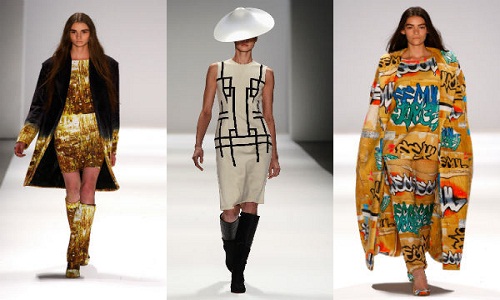
About 75 per cent of garment workers worldwide are women. Up to 75 million people are employed by the fashion industry globally right now. In 2000, only 20 million people were believed to be employed by the industry. In the US, cotton pickers make an average of $40,000 per year. In India, the average employee makes $730 per year. In Uzbekistan, workers may not earn anything at all. In 2004, it was estimated that the informal economy within the fashion industry generated 35 per cent of global GDP, the figure is likely to be higher now.
The fact is that, though a majority of manufacturing occurs outside the US and Europe a majority of sales occurs inside the US and Europe. Economies everywhere are able to benefit from what this industry contributes. Whether there are ethnic, cultural, or national fashion trends that are emphasised, there is always a niche available for designers, manufacturers, and retailers. Although the US often dominates the fashion industry in terms of imports and influence, there really is something for every demography, if you are willing to look hard enough.
Understanding fashion
Fashion is more than just what you decide to add to your wardrobe. It is an industry, which provides manufacturing jobs, accounting jobs, and even entry-level retail jobs so that everyone has a chance to get involved. Specialist positions, like an accountant, earn an average $8,3000. When there are skills involved, then people can earn an income in the US that is at or above the average annual house hold income and that helps to grow economies, provide for family needs, and contribute to the growth of other industries. In the US, the average household spends about $1,700 per year on fashion items, including apparel, footwear, and related accessories.
Children’s fashion is expected to exceed $200 billion in total sales annually, which marks a 15 per cent increase in the past five years. Bridalwear is a fashion market, which generates more than $55 billion annually. Menswear generates more than $400 billion each year around the world; women’s wear contributes more than $620 billion in sales to the fashion industry annually.
Fashion becomes a priority for consumers, when other basic needs can be met, and there is money left over. No one is going to spend $300 on leather shoes when they need to put food on their table, pay their rent or mortgage, and have a way to get to work. Yet for this industry being a secondary priority, the total amount of sales that it achieves annually is quite impressive. If you can find the right niche within this industry, then you can become instantly competitive. That is why jobs continue to be created, often high paying, and why so many are pursuing an education in this field right now.
The Ludhiana garment industry majorly uses three kinds of yarn- 100 per cent cotton, blended yarn (polyester/ cotton mixed) and 100 per cent polyester.
Due to rise of crude prices in the international market, prices of polyester yarn have increased to Rs 5 per kg. There are different kinds of yarns even in the polyester category and prices vary accordingly.
Secondly, the production of raw cotton in India came down to 325 lakh bales this year as compared to about 370 lakh bales last year. There was a reduction up to about 12 per cent. Due to slightly good demand of cotton and better exports, there arises a scarcity of raw cotton. Export of raw cotton overseas was about 60 to 65 lakh bales.
Increased rates of yarn are going to affect the garment industry badly. The increased rates would put more of a financial burden. The reduced VAT tax rate has not made any difference. Garment manufacturers fear that with rates of yarn increased, the consumer would pay more to buy the end product.
There is a feeling that instead of exporting raw cotton to other countries, value addition on yarn by making garments is a better option.
Option to recycle textiles, such as old clothing, is available now. Each year, Massachusetts residents throw away 230,000 tons of textiles, while 95 per cent of this waste can be recycled or reused in some manner. The Secondary Materials and Recycled Textiles Association, Council of Textile Recycling and Massachusetts Dept. of Environmental Protection are launching a statewide textile recycling initiative in Massachusetts to encourage residents to reduce the amount of clothing and other textiles they throw away.
Across the state, Municipalities will promote textile recycling at the community level. Local recycling coordinators will facilitate textile collections and educational events throughout the year to raise awareness of textiles as a household recyclable.
While textile items cannot be placed in curbside collections with other household recyclables, for-profit, thrift and charitable organizations alike accept donations and begin the textile recycling process. These organisations accept any fabric-based items that are clean and dry, including unwanted and damaged clothing, towels and linens, footwear, belts, hats, accessories, handbags, pillows, stuffed animals and more.
According to SMART, approximately 45 per cent of textiles in the recycling stream are reused as secondhand clothing, both in retail storefronts and in mass in developing countries. Companies like a SMART member, ERC Wiping Products in Lynn, Massachusetts, convert another 30 per cent of textiles to industrial rags. The remaining 20 per cent is sent to textile converters who remanufacture textile fibers into other products, such as automotive and housing insulation, carpet padding and sound dampening products.
To meet their growing demand, Taiwanese composite and technical textile companies are exploring partnership opportunities with Indian firms across various industries.
Over the next five years, India's technical textile industry is expected to grow at a rate of 20 per cent annually to touch $30 billion. The composite industry is also pegged at $2.2 billion with an expected growth of 15 per cent per annum over the next four years.
The Bureau of Foreign Trade (BOFT) and Taiwan Textile Federation (TTF) are forming the Taiwan Pavilion for the fourth time jointly with Taiwan Composites Association (TCA) participating in ‘Technotex 2016,’ organised by the Ministry of Textiles and an industry body in Mumbai soon.
At the event, nineteen leading Taiwanese companies producing high-end composites, innovative technical textiles, raw materials, accessories and non-woven machinery will exhibit their products. The multiple industries and sectors Taiwan is focusing on include automotive, defence, police, fire departments, sports gear and apparel, rainwear, outdoor tents and canopies and protective and safety products among others.
A.T.E. Enterprises Private Limited of India, manufacturer of textile machinery have entered into a strategic partnership with Italian group Savio Macchine Tessili from for sales and marketing of Automatic Winders, Two-For-One Twisters (TFO), Continuous Yarn Shrinking Machines, OE Rotor Spinning Machines in India.
Established in 1911, the Savio group for more than 100 years of experience and has played major role in development of textile industry worldwide and with its manufacturing facilities in Italy, Czech Republic, India and China that offers state of the art machines. Savio India Ltd., the advanced TFO manufacturing set up of Savio group in India, will continue to provide and ensure state of the art Customer Support and Spare Parts Services.
Meanwhile, it will be noted that A.T.E. group, with its strong marketing network through 11 offices across India and a knowledgeable sales and marketing force, complements the competence of the Savio group as Savio’s sales and marketing partner in India. A.T.E. is in the unique position of being the only company with a presence across the entire textile value chain for textile machinery & accessories, utilities and complete after sales service solutions (for key segments). A.T.E. thus is the only company with the capability of offering to Indian customers a ‘one window solution’ from spinning to garment making.
Oerlikon has signed an agreement to acquire the entire staple fibers technology portfolio of Trützschler Nonwovens & Man-Made Fibers GmbH, Egelsbach, Germany. This company is part of the German Truetzschler Group, which is a specialist in fiber preparation for the yarn spinning and nonwovens industries.
The acquisition expands the manmade fibers segment’s technology portfolio and opens up access to new customers in the market for synthetic staple fibers.
Roland Fischer, CEO of the Oerlikon Group, said, “The acquisition is an important step in line with our strategy to strengthen our position outside the filament business, where we occupy a leading technology and market position. The ongoing consolidation in the chemical fibers market presents interesting opportunities and we are taking this step to ensure that the manmade fibers segment will merge stronger from the current market weakness and profit from the positive long-term market perspectives.”
With the acquisition of the former Fleissner staple fibers technology portfolio and the intellectual property (IP) of Trützschler Nonwovens & Man-Made Fibers GmbH, the segment becomes the leading technology and equipment provider in the global staple fibers market.
The acquisition expands the manmade fibers segment’s staple fibers technology expertise and broadens the segment’s customer base and service business in the respective areas. As staple fibers projects are increasingly tied to continuous polycondensation facilities, already now the manmade fibers segment is well positioned to operate as a provider of complete solutions. Truetzschler Group is discontinuing its staple fiber business as it has decided to focus on its core business activities.
In 2015, the produced staple fibers amounted to 18.5 million tons or some 33 per cent of the total synthetic staple fibers capacity.
Tom Young, Overseas Department Sales Manager, Shenzhen Ink Bank Graphic Technology Co. Ltd, one of the exhibitors in TPF explains that types of inks available and their application for textile digital printing. They come with their own features that suit various requirements.
Sublimation has applications for mostly fabric with more than 60 per cent polyester fibers. Textile printing with Reactive inks has applications for cotton, silk, wool, rayon and blended fabrics. Pigment is suitable for cotton, canvas, blended etc. There are also advertisement inks and office printing inks.
Sublimation is most popularly selling because now digital printing is getting more and more popular. And there is no need of screen printing and it can take on small quantity orders. The order can be taken the same day and executed simultaneously without any time lag.
Reactive dyes have advantages. There is no need to make screen; small quantities can be undertaken; it’s less polluting and is energy saving. Textile pigment ink can support almost every fabric. In addition to the advantages of reactive dyes, there is no need for washing or steaming. There is good color fastness. It has vivid colors and uses less energy. Nowadays pigment ink application is growing much faster than others.
Du Pont is the leading supplier of innovative and high quality inks and materials that enable faster and more efficient digital printing.
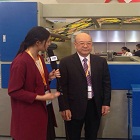
Keycheng printing machinery from Taiwan, one of the participants in ongoing TPF 2016 fair for digital printing technology, has a cutting edge idea to present, “The machine which we have displayed, is a revolutionary advancement to the conventional printing machine as it runs on CMYK concept and is a functional hybrid between conventional and digital printing machine”, according to Yao Ya-Hsing, General Manager Keycheng.
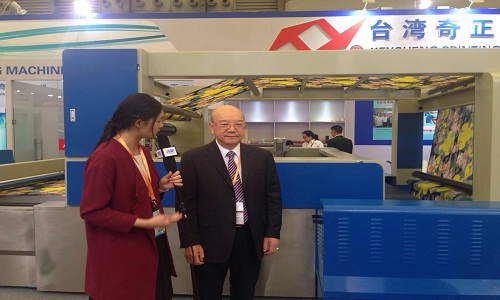
He claims, “The printing fabric quality it offers is more real. The kind of the penetration it can provide can't be matched by any other form of printing. It can support any thickness of the fabric as there is no ‘gsm’ restrictions compared to digital printing which surely has restrictions. Here there is no coating required while the same is not true even in digital.”
“The machine is by design meant for mass production and can achieve anywhere between 40000-50,000 metres per day which only rotary can match, but rotary has limitations of quite different sorts like of lack of precision it delivers and can have only repeat of 640 mm, whereas here there is no repeat restrictions. Over here there is no restrictions of type of fabrics as well, it can work on cottons, viscose, nylon and polyester-cotton, all with equal ease, whereas digital is more effective on polyester etc. Besides, colour spectrum is very wide you can literally run your imagination wild. The best part of it is machine is incredibly low running cost as low as fifth of any printing machine. Initially preparation screen time use to be high but now with new advanced 'Blue Ray’ system, it’s cut down on the preparation time quite a bit.” Explains Yao.
“As any CMYK concept machine requires low water consumption and then again it's recycled for resource conservation. Energy costs are also supposed to be less than conventional printing process. Since it uses Japanese parts from Yasakawa and electrical components from Fuji,Japan or Germany it's very stable and doesn't need any intense preventive maintenance, doesn’t break down so easy, therefore no trouble shooting is generally required. “ emphasises Yao Ya-Hsing
Speaking in Digital Printing Conference ( TPF) on April 16, Stewart partridge, Consulting Partner, Inkjet Alliance mentioned that “Large percentage of digital textile printing as of now is sublimation transfer, and there is a lower percentage of Direct printing and pigment ink printing than in the analogue textile sector, but as we move forward pigment printing will become increasingly popular, especially as technological hurdles in print heads and ink chemistry are overcome.”
He further added, “as a matter of fact, some of the fastest print heads struggle with pigment printing today, and ink and print head manufacturers need to collaborate more to solve these challenges.”
However, overnight change to pigment ink is not easy, and progress will likely happen in incremental steps over several years, as per him. Later, it is likely that pigmented inks will become a preferred option, because of their durability, light fastness and ability to adhere to a wide range of fabrics. This will leave us with a more even spread of inkjet printing between the four available ink chemistries: reactive, acid, disperse, sublimation and pigment.
The four ink family i.e. Reactive for cotton/cellulose, Acid for Silk/Nylon, Sublimation for Polyester/Nylon 6 and Pigment potentially for many fabrics , makes it very versatile. Heat fixation also enables further reduction in water usage, and minimizes effluent.
The two main influencers in ink jet are, he mentioned, “ one the print head that determines the ink deposit, resolution and defines the limitations of ink used; and the second is ink chemistry itself. It is the ole of OEM or machine manufacturers’ to integrate those technologies, together with the other hardware, transport system, software and media to provide a reliable total printing system.”
Talking further, he said in the economic recession things take a dip, and we also see changes in fashion cycle which affects design and the actual volume of printing produced. The launch of the new generation fast and multiple heads technology makes a forward move.
“The opportunities for digital textile printing in the future are not limited to more of the same, or simply replacement of analogue printed textiles. There are growing opportunities for technical textiles in areas such as military use, medical use, thermal and environment control, and many others, both within as well as outside the textile industry” he summed up.



